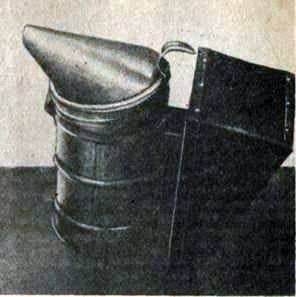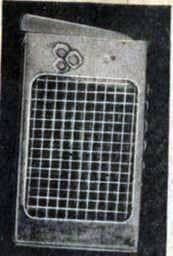Beekeeping tools

As with any specialist, the beekeeper has his own tools, his own special equipment.
Perhaps the most necessary and indispensable tool of the beekeeper is a beekeeping chisel. Fig. 20. Beekeeping chisel.
Without it, you can not separate the housing from the housing, raise the ceiling of the hive, move the honeycombs apart, or remove the frame from the nest.
With chisels, waxen growths and propolis are scraped off the frames, and the walls, the bottom and the folds of the hive are cleaned. It serves the beekeeper the same way as a trowel to a builder or a brush artist. Without a trowel, you can not build a house, but without a brush you can not create a picture on the canvas. And it’s just as simple as the device. Steel L-shaped plate with expanded and pointed ends. That’s all. And without it, like without hands. And the hive has nothing to approach. An experienced beekeeper owns it masterfully.

Fig. 21. The Dymard.
Just serves faithfully the beekeeper and the smoke – an iron cylinder with a cone-shaped lid and furs for blowing smoke.
They put in it smoldering materials that give a lot of smoke: wood rotten, dung, a piece of sackcloth wrapped with a tube, moistened with automotive oil. This car refueling is effective for several hours, and the rotten fires are burned quite quickly.
Put healthy wood in the smoke. Smoke from it is not enough, and it is very hot, it burns bees.
The smoker allows you to inject smoke anywhere in the nest to drive away and tame the bees. He is called the right hand of the beekeeper.
Often during the examination of the nest, it is necessary to remove frames from it with honey, brood and bees sitting on them. Leaning them to the hive is not always convenient and, most importantly, unsafe.
Foreign bee-scouts will immediately detect
A long handle is attached to the side walls of the box. It is convenient to carry frames with empty honeycombs and a wax from the pantry to the apiary to put them in the hives. A portable box is made of plywood. When the bees remove the queens, there are many in the apiary.

Fig. 22. Cell for the uterus.
Valuable queens, which are then thought to be used in their household, are stored in a reticulated uterine cell that resembles a matchbox and is almost the same in size. There are two ways out: one is locked by an iron flap, the other by a wooden pier, in which a recess is drilled, where the food for the uterus is put.
Within a few days the uterus can live in this iron castle until it is released by the beekeeper or the bees themselves, when he lets them do so.
The queens are retained either to replace the old ones with young ones, or to give them to new families when they increase the apiary. They will also be needed for the organization of twin-family families, when they prepare additional bees’ reserves for honey. So a small cell is very necessary for beekeepers and for large apiaries.
If there is an apiary, then there must be honey. After all, that’s why the bees are driven to be with honey. And how to take it from the combs, so as not to destroy them and again to return them to the nests? For this, too, there are tools – a knife and a honey extractor.
An apiary knife is not the same as a regular dining room. At the handle it is bent almost at right angles. This is done for the convenience of unpacking the honeycomb plane: after all, honey bees are stored with closed wax plates. A knife is sharpened on both sides. The end is sharpened so that it is possible to open honey cells in the depressions and hollows of the honeycomb. The knife is heated in hot water. This makes it easier to print. It is necessary to have two knives. While one cools, the other heats up. This speeds up the work. In practice, often used more advanced knives – steam and electric. Large industrial beekeeping farms use automatic copying machines.
The honey extractor is designed to extract honey from honeycombs. The principle of its operation is based on centrifugal force. Sometimes it is called centrifugal. The honeycomb is placed honeycombs, they rotate, honey from the cells splashes out, sprays on the tank wall and flows down to the bottom. Through the tap it is poured into the dishes.
We know of the 2- and 4-frame honey extractors and electric 20- and 50-frame ones. These large medobonkami are used in large beekeeping farms, where honey is pumped out in tons. For the school apiary, a 2-frame honey extractor is also suitable. It is trouble-free in work and can serve for many years.
As you can see, the beekeeper has technical means with which he is able to perform any necessary operation. You can buy them in special beekeeping stores. They exist in almost every city and district.
Beekeeping tools
